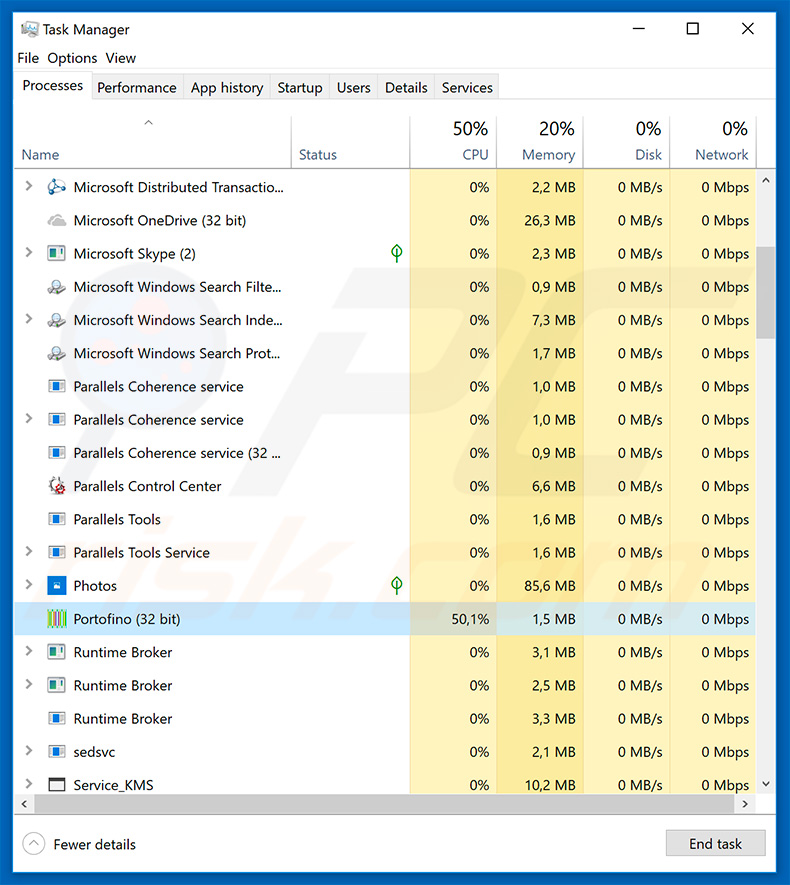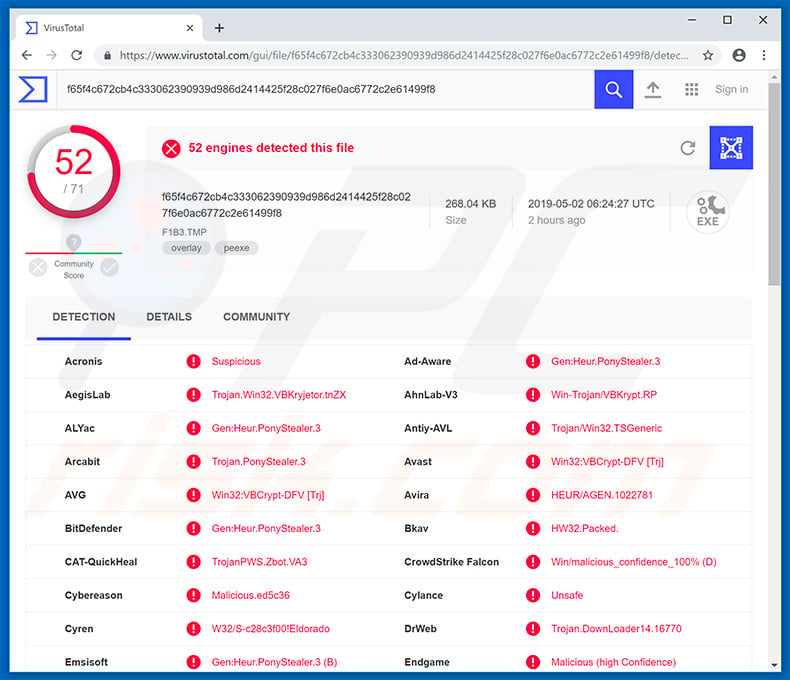Get free scan and check if your device is infected.
Remove it nowTo use full-featured product, you have to purchase a license for Combo Cleaner. Seven days free trial available. Combo Cleaner is owned and operated by RCS LT, the parent company of PCRisk.com.
What is Kovter?
Kovter (also known as Trojan.Kovter, Trojan:Win32/Kovter, and Trojan.Kovter.297) is an adware-type trojan designed to generate traffic for various websites. Research shows that Kovter is typically proliferated using malicious Microsoft Office attachments (which are distributed using spam email campaigns) and another trojan.

Kovter has an interesting feature that enhances its ability to avoid detection. Unlike most infections, Kovter is not stored in any file. Cyber criminals install this malware by creating a number of entries in Windows Registry. In this way, they can maintain Kovter in systems without having to store detectable files. The main purpose of Kovter is to generate traffic for various websites.
It runs a number of Internet Explorer instances in the background. These are used to visit websites and emulate clicks on advertising links/banners. In this way, cyber criminals can generate web traffic and revenue. The presence of these infections can cause a number issues.
System performance significantly diminishes, since running Internet Explorer processes uses many resources. Furthermore, Kovter might be used to visit malicious websites and, thus, its presence can lead to system infections. Kovter can be detected in various ways.
It usually runs a randomly-named process in Windows task manager (e.g., the sample we analyzed ran a process called "Portofino"). You should also be able to see multiple Internet Explorer processes. Kovter's Windows Registry entries are named using unreadable characters, and thus the default Registry Editor is unable to display them properly.
Fortunately, anti-virus/anti-spyware suites are able to detect such infections and eliminate them. Therefore, if you have noticed any of the aforementioned symptoms, immediately run a full system scan and eliminate all detected threats.
| Name | Trojan:Win32/Kovter |
| Threat Type | Trojan, adware-type infection. |
| Detection Names | Avast (Win32:VBCrypt-DFV [Trj]), BitDefender (Gen:Heur.PonyStealer.3), ESET-NOD32 (a variant of Win32/Injector.CCKM), Kaspersky (Trojan.Win32.VBKryjetor.vya), Full List (VirusTotal) |
| Malicious Process Name(s) | Portofino (the process name may vary on Kovter's variant). |
| Additional Information |
Kovter trojan does not store any files on the system and resides entirely in Windows Registry. |
| Symptoms | Trojans are designed to stealthily infiltrate the victim's computer and remain silent. Thus, no particular symptoms are clearly visible on an infected machine. |
| Distribution methods | Infected email attachments, malicious online advertisements, social engineering, software cracks. |
| Damage | Decreased computer performance and internet speed, lack of system resources. |
| Malware Removal (Windows) |
To eliminate possible malware infections, scan your computer with legitimate antivirus software. Our security researchers recommend using Combo Cleaner. Download Combo CleanerTo use full-featured product, you have to purchase a license for Combo Cleaner. 7 days free trial available. Combo Cleaner is owned and operated by RCS LT, the parent company of PCRisk.com. |
The internet is full of trojan-type infections (e.g., Bolik, Tofsee, TrickBot, Hancitor, and Ursnif), however, Kovter is rather uncommon. Infections of this type often proliferate other malware or collect sensitive information.
The risk of these infections is typically much higher - their presence usually leads to system infections (e.g., ransomware, cryptominers, etc.) and privacy issues (credit card/identity theft, financial loss, and so on). Therefore, as compared to these other trojans, Kovter is not particularly harmful.
In any case, eliminating trojans and other system infections is paramount, no matter what their potential for system damage.
How did Kovter infiltrate my computer?
As mentioned above, Kovter is typically proliferated using malicious Microsoft Office documents and another trojan type infection called Trojan.MulDrop6.42771. Malicious MS Office documents are usually distributed as attachments to various spam emails.
Once opened, these documents ask to enable macro commands, which, once executed, download and install malware into the system. Trojans such as Trojan.MulDrop6.42771 stealthily infiltrate computers and inject them with additional malware.
It is currently unknown exactly how developers proliferate Trojan.MulDrop6.42771, however, these infections are generally proliferated using the aforementioned spam email campaigns, fake software updaters/cracks, and third party software download sources.
Fake updaters and cracks install malware rather than updating/cracking software. Third party download sources present malicious executables as legitimate software, thereby tricking users into downloading and installing malware manually.
How to avoid installation of malware?
The main reasons for computer infections are poor knowledge and careless behavior. The key to computer safety is caution. Therefore, pay attention when browsing the internet and downloading/installing software. Handle email attachments with care. If the file/link is irrelevant (does not concern you) or the sender is suspicious, do not open anything.
Bear in mind that cyber criminals often use scams (e.g., "you have won a lottery", "money has been transferred to your account", "you have received a package", etc.) to trick unsuspecting users. Do not fall for these scams. Download software from official sources only, preferably using direct download links.
Keep installed operating systems and software up-to-date, however, use implemented functions or tools provided by the official developers. Software piracy is a cyber crime and the risk of infections is extremely high. Software piracy should never be considered.
Have a reputable anti-virus/anti-spyware suite installed and running at all times. This software can detect and eliminate malware before it harms the system. If you believe that your computer is already infected, we recommend running a scan with Combo Cleaner Antivirus for Windows to automatically eliminate infiltrated malware.
Kovter threat names in various anti-virus engines:

Instant automatic malware removal:
Manual threat removal might be a lengthy and complicated process that requires advanced IT skills. Combo Cleaner is a professional automatic malware removal tool that is recommended to get rid of malware. Download it by clicking the button below:
DOWNLOAD Combo CleanerBy downloading any software listed on this website you agree to our Privacy Policy and Terms of Use. To use full-featured product, you have to purchase a license for Combo Cleaner. 7 days free trial available. Combo Cleaner is owned and operated by RCS LT, the parent company of PCRisk.com.
Quick menu:
How to remove malware manually?
Manual malware removal is a complicated task - usually it is best to allow antivirus or anti-malware programs to do this automatically. To remove this malware we recommend using Combo Cleaner Antivirus for Windows.
If you wish to remove malware manually, the first step is to identify the name of the malware that you are trying to remove. Here is an example of a suspicious program running on a user's computer:

If you checked the list of programs running on your computer, for example, using task manager, and identified a program that looks suspicious, you should continue with these steps:
 Download a program called Autoruns. This program shows auto-start applications, Registry, and file system locations:
Download a program called Autoruns. This program shows auto-start applications, Registry, and file system locations:

 Restart your computer into Safe Mode:
Restart your computer into Safe Mode:
Windows XP and Windows 7 users: Start your computer in Safe Mode. Click Start, click Shut Down, click Restart, click OK. During your computer start process, press the F8 key on your keyboard multiple times until you see the Windows Advanced Option menu, and then select Safe Mode with Networking from the list.

Video showing how to start Windows 7 in "Safe Mode with Networking":
Windows 8 users: Start Windows 8 is Safe Mode with Networking - Go to Windows 8 Start Screen, type Advanced, in the search results select Settings. Click Advanced startup options, in the opened "General PC Settings" window, select Advanced startup.
Click the "Restart now" button. Your computer will now restart into the "Advanced Startup options menu". Click the "Troubleshoot" button, and then click the "Advanced options" button. In the advanced option screen, click "Startup settings".
Click the "Restart" button. Your PC will restart into the Startup Settings screen. Press F5 to boot in Safe Mode with Networking.

Video showing how to start Windows 8 in "Safe Mode with Networking":
Windows 10 users: Click the Windows logo and select the Power icon. In the opened menu click "Restart" while holding "Shift" button on your keyboard. In the "choose an option" window click on the "Troubleshoot", next select "Advanced options".
In the advanced options menu select "Startup Settings" and click on the "Restart" button. In the following window you should click the "F5" button on your keyboard. This will restart your operating system in safe mode with networking.

Video showing how to start Windows 10 in "Safe Mode with Networking":
 Extract the downloaded archive and run the Autoruns.exe file.
Extract the downloaded archive and run the Autoruns.exe file.

 In the Autoruns application, click "Options" at the top and uncheck "Hide Empty Locations" and "Hide Windows Entries" options. After this procedure, click the "Refresh" icon.
In the Autoruns application, click "Options" at the top and uncheck "Hide Empty Locations" and "Hide Windows Entries" options. After this procedure, click the "Refresh" icon.

 Check the list provided by the Autoruns application and locate the malware file that you want to eliminate.
Check the list provided by the Autoruns application and locate the malware file that you want to eliminate.
You should write down its full path and name. Note that some malware hides process names under legitimate Windows process names. At this stage, it is very important to avoid removing system files. After you locate the suspicious program you wish to remove, right click your mouse over its name and choose "Delete".

After removing the malware through the Autoruns application (this ensures that the malware will not run automatically on the next system startup), you should search for the malware name on your computer. Be sure to enable hidden files and folders before proceeding. If you find the filename of the malware, be sure to remove it.

Reboot your computer in normal mode. Following these steps should remove any malware from your computer. Note that manual threat removal requires advanced computer skills. If you do not have these skills, leave malware removal to antivirus and anti-malware programs.
These steps might not work with advanced malware infections. As always it is best to prevent infection than try to remove malware later. To keep your computer safe, install the latest operating system updates and use antivirus software. To be sure your computer is free of malware infections, we recommend scanning it with Combo Cleaner Antivirus for Windows.
Share:

Tomas Meskauskas
Expert security researcher, professional malware analyst
I am passionate about computer security and technology. I have an experience of over 10 years working in various companies related to computer technical issue solving and Internet security. I have been working as an author and editor for pcrisk.com since 2010. Follow me on Twitter and LinkedIn to stay informed about the latest online security threats.
PCrisk security portal is brought by a company RCS LT.
Joined forces of security researchers help educate computer users about the latest online security threats. More information about the company RCS LT.
Our malware removal guides are free. However, if you want to support us you can send us a donation.
DonatePCrisk security portal is brought by a company RCS LT.
Joined forces of security researchers help educate computer users about the latest online security threats. More information about the company RCS LT.
Our malware removal guides are free. However, if you want to support us you can send us a donation.
Donate
▼ Show Discussion